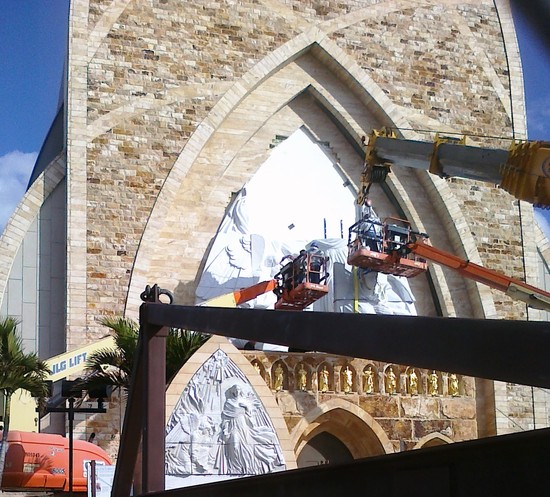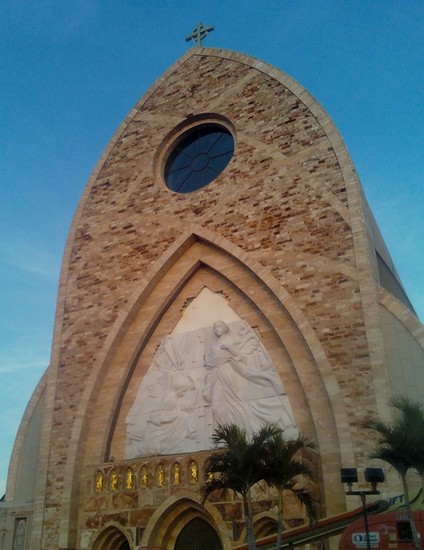Postcard From Florida
/First the great news. On January 14, the last block of Carrara marble — from the same vein from which Michelangelo carved David — was lifted into place by huge cranes (cost: $300 per hour, over three weeks of herculean overtime work) onto the façade of the Oratory at Ave Maria University in Florida.

Only a little more often than once per century are high-relief marble sculptures hoisted onto the façades of large-scale cathedrals and oratories. The last such façade installed in the United States was Frederick Hart’s magnificent Ex Nihilo at the National Cathedral in Washington, D.C. Ave Maria’s new marble — the archangel Gabriel announcing the forming of Jesus in embryo in Mary’s womb — now takes its place with Hart’s as one of the most arresting and beautiful in the New World. Its lines are as clear and simple as the lovely face of the 16-year-old Mary. Its quiet majesty induces awe. It forces onlookers to linger over that moment in history when God became Man, in the flesh of the Blessed Virgin.
Throughout the long centuries of Christian history, the Annunciation has been the most often carved and painted scene from the Bible. Everything else in Christian history follows from it. Here it is that God first takes flesh in man, by an act of humble obedience on Mary’s part. His time in Mary’s womb is proof that Jesus Christ is man, just as his love, miracles, death, and resurrection prove that he is God. Thus it is that whenever the Creed is recited at Mass, all heads are bowed at the line: “By the power of the Holy Spirit he was born of the Virgin Mary, and became man.”
Trumpets! Jubilation! That is the mood I felt on watching the last few large blocks of heavy marble being lifted into place on the gothic archway, as the light of the fading sunset reddened the pure white stone, and bystanders and workers cheered in relief after days and days of suspense. The total weight of the marble exceeds 60 tons. One mistake, one sagging line, and the whole project might have been ruined for a long time.
Thus does Ave Maria continue its strides toward becoming the center of sculpture, sacred music, painting, prints, and other arts in southwest Florida. Coming next: Verdi’s lovely Requiem, recently performed before Pope Benedict in Rome, will soon be performed by the Naples Opera Company at Ave Maria University’s new Golisano Field House (with far more seating than the Oratory).
Now for the high praise. It came from a recent issue of First Things reporting on Catholic higher education in America. This fresh survey ranked young Ave Maria as third among all Catholic schools in academic quality, behind only Notre Dame and Georgetown. More centrally than that, First Things ranked Ave Maria first in Catholic character and culture. On that count, Georgetown ranked among the last, and Notre Dame received a mixed review. First Things quoted one Ave Maria student who said (properly, in my observation) that some students there, upon entering, are not Catholic, or not very seriously so; but by the end of four years, virtually every student has become more religious.
Almost at the same time, in surveying all the colleges and universities of the United States that are found in rural environments, Newsweek placed Ave Maria 16th, in the company of such luminaries as Dartmouth, Amherst, Williams, St. Olaf, Colgate, Carleton, and Bucknell.
That was the high praise — the really great news — for a campus only seven years old. And that’s only the beginning of what AMU is working to build. Its faculty and administration view Ave Maria as an Explorer of the Future, striving to outline a new future for American education and indeed for the culture of the West. Exactly in this vein, however, the university has lost an enormous opportunity.

The great research company and network Jackson Labs has been much wooed by developers around the United States during its search for a location to build a new campus for computer-based research. There was for a time a good chance that Jackson Labs would locate close to Ave Maria, and that the university community would receive this huge intellectual lift, however controversial the coming of Jackson Labs was deemed by some. But as of the last few days, it appears that the company has agreed to an offer from a developer in a different part of southwest Florida, to the north in Sarasota.
AMU’s Department of Theology is fortunate in the presence of the distinguished theologian from Cardinal Schönborn’s Vienna, Michael Waldstein, certainly one of the theologians most highly sought by the major universities. Waldstein recently delivered a stirring public defense of the great good fortune of having a frontline technology company settle just four miles from AMU’s campus.
Waldstein bewailed the too frequent Catholic habit in recent centuries of bemoaning secular scholarship, while hiding one’s head from it, not engaging it, attempting to wish it away. That is the way, he argued, to fall farther and farther behind.
Waldstein welcomed the near-coming of Jackson Labs to the university area as a dream he had long devoutly prayed for — a chance to engage with cutting-edge explorers on the frontiers of new knowledge, learning from them and raising new questions that might not normally come into their view. The results of this engagement, he argued, would be enormously advantageous to him, in bringing him new knowledge immediately and at first hand, not as later reported in distant, and possibly polemical, journals. It would make him and other fortunate theologians much more sharply versed in the leading methods and findings of contemporary research, as well as in its assumptions, some of them perhaps dubious. The presence of Jackson Labs would force theologians like himself to design sharper statements of more appropriate basic assumptions.
For others at Ave Maria who opposed the coming of Jackson Labs, the fear was that while Jackson Labs does not currently conduct human-embryonic-stem-cell research, it has not ruled out the possibility of doing so in the future. The local Ordinary, Bishop Frank Dewane, took this approach, and there is merit in these concerns, however speculative they are at this time. This concern is shared by Waldstein and others at AMU.
No doubt, the leaders of Jackson Labs quickly learned of the strong moral convictions of the university; they needed only to look at its clear mission statement. Furthermore, the faculty, staff, and students at AMU, not to mention the vast majority of those attracted to the town of Ave Maria, are vehemently opposed to human-embryonic-stem-cell research. In fact, one could argue that in the spirit of mutual inquiry and frank discussion, those at Jackson Labs might have been challenged to consider some moral points they had not thought of, just as the ethicists of AMU would likewise have been challenged to sharpen their concrete knowledge of fast-arising developments in the field of bioethics.
But all this, it now appears, is not to be. Jackson Labs seems to be moving elsewhere. Some of the faculty here regard this as a great opportunity lost. These visionaries are longing for opportunities to pioneer a new way of addressing new technologies and new empirical methods of inquiry. They hope not to bury their heads in the sand regarding these questions, and not to avoid them, but to study the issues from a fresh Catholic point of view. Indeed, most of those at AMU hope to make the university an institution of exploration and creativity, not simply an institution of retreat from the world.
For Ave Maria University, there is no doubt about the central moral imperative in this debate: Human-embryonic-stem-cell research is objectively immoral, since it depends on the destruction of a live human individual (with her or his own individual genetic code).
On that moral principle, Ave Maria University stands foursquare with the Pope, the United States Conference of Catholic Bishops, and its local Ordinary.

But so saying does not alone heal the three-century rupture between secular scientists, some with obviously atheistic and materialistic assumptions about the nature of reality, and serious religious thinkers who are not afraid to face such questions head-on. Ave Maria wants to be a new sort of Catholic institution — one not without precedent in the past, but urgently needed now and in the future.
For now we are grateful for our great new sculpture by Martón Váró, and the high praise from First Things and Newsweek. On the scientific front, let us hope we shall have another opportunity to engage the best scientific explorers in the nation “up close and personal.”
Michael Novak sits on the Ave Maria University board of trustees. His latest book is No One Sees God. His website is www.michaelnovak.net.
Published in National Review Oniine January 31, 2011
